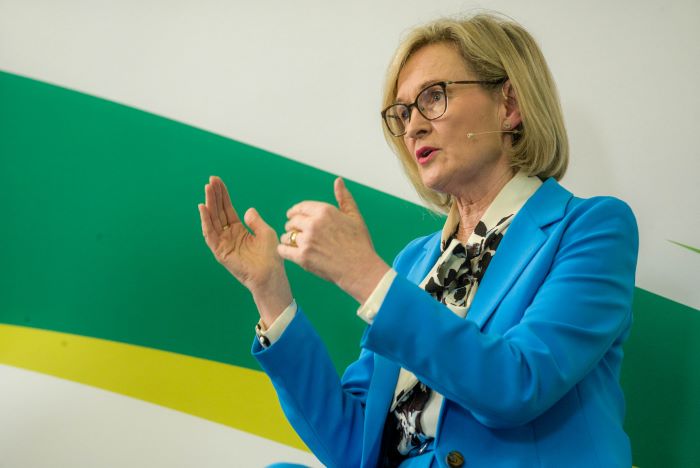
12 November 2023

During the opening and closing of her address to the recent conference on Irish Agriculture and the EU 50 years on, a journey through 50 years of Ireland’s EU membership, EU Commissioner Mairead McGuinness posed the question ‘where are the women?’
The conference opened with an interesting video that took a look back on Irish agriculture over the past 50 years, since joining the EEC. It highlights some significant moments and changes in agriculture during that timeframe. In the early shots women were absent, prompting the Commissioner’s ‘were are the women’ comment. This video can be viewed below
The Commissioners address and the Q and A after touched on many significant changes and events for agriculture over the past 50 years and earlier in some instances. Here are some of the interesting facts and points she addressed.
Mairead McGuinness is the European Commissioner for Financial Stability, Financial Services and the Capital Markets Union since October 2020. She is the only native English speaker at the table of 27 commissioners. She is also the only comissioner to live on a farm and she emphasised that finance matters to farming and agriculture.
Sicco Mansholt, Juan Greene and the early years
Farmers were mainly enthusiastic about joining the EEC. There was the fact that we would be part of something bigger and that things would improve farmers. Back in the 1950s Juan Greene the first leader of the National Farmers Association spoke about joining the EEC but it took quite some time as Ireland could not join without the United Kingdom. It took until 1973 when Ireland, the UK and Denmark joined.
Sicco Mansholt was a Dutch farmer who witnessed famine in his native country following the Second World War. He was determined to ensure that this would not happen again. In 1950, he developed a plan for a common market for agricultural produce in Europe.
Though it failed at the time, it was later revived and was the inspiration behind the agricultural policy of the European Economic Community. Mansholt got his chance to launch his plans for a common policy when he became Commissioner for Agriculture in the very first European Commission in 1958. It took until 1968 for his plans to overcome opposition and materialise.
The agricultural policy was very successful in meeting its initial objective of making Europe more self-sufficient with food products. Though it did lead to beef and butter mountains, milk and wine lakes, changes to the policy were required to address this issue. However, in the 50+ years of its existence it has undergone major changes in order to adapt to new times.
Going from net beneficiaries to net contributors
When Ireland joined the EEC in 1973 and up until 2018 Ireland was a net recipient of EU funds. The country is now a net contributor due to it’s significant economic growth. Since the 1960s, European Union member countries have pooled resources together to finance projects that make a difference to the lives of European citizens.
For Ireland, the EU budget has helped transform our economy from an agriculture dependent economy to one largely driven by hi-tech industry and global exports. It has also funded a number of important infrastructure projects such as major inter-urban motorways, Dublin Port Tunnel and the DART
Making Agriculture more sustainable
Climate change and the loss of biodiversity are now major issues that need to be addressed. Recent flooding has caused many farmers to reflect on what they are doing – ‘sometimes you can’t battle floods’. Indeed many of the policies of the past are no longer suitable or acceptable in current times.
It is a challenge for farmers to refocus their thinking from what they were taught years ago. When the Commissioner was involved in ‘Ear to the Ground’ she remembers doing programmes on taking out hedegerows efficiently, draining land etc. Indeed many farmers particularly older farmers may find the change difficult. It is a challenge that must be embraced, farmers must be helped to change.
Farm policy became too one dimensional and was only focussed on production. There is now a need to focus on what is working, what is not working and what we need to change. Farmers need to be core to the change and involved in the dialogue around change. Farmers are already adapting and giving consideration to environmental issues and this must be recognised.
Where are the women?
Women are becoming more visible in farming and agriculture, but it is still in small numbers. Yet they are likely to be the drivers of change. Their contribution to farming and the farm must be recognised and valued – they should not be ignored.
A recording of the event is available here. The Commissioner’s address ssssstarts at 32 min and 50 seconds and last for just over 20 min. The Q & A with the Commissioner follows immediately.
Irish agriculture over the past 50 years






